Spotify and BMG have entered into a direct, multi-year US publishing licensing agreement.
According to the announcement, the deal is “designed to deliver greater value to songwriters and their teams”.
“This agreement…

Spotify and BMG have entered into a direct, multi-year US publishing licensing agreement.
According to the announcement, the deal is “designed to deliver greater value to songwriters and their teams”.
“This agreement…

Fifty years after Linda Ronstadt’s Prisoner in Disguise came out, the Rock & Roll Hall of Fame inductee is looking back at the album that further cemented her reputation as a ‘70s pop superstar and supreme song interpreter, as Mobile…
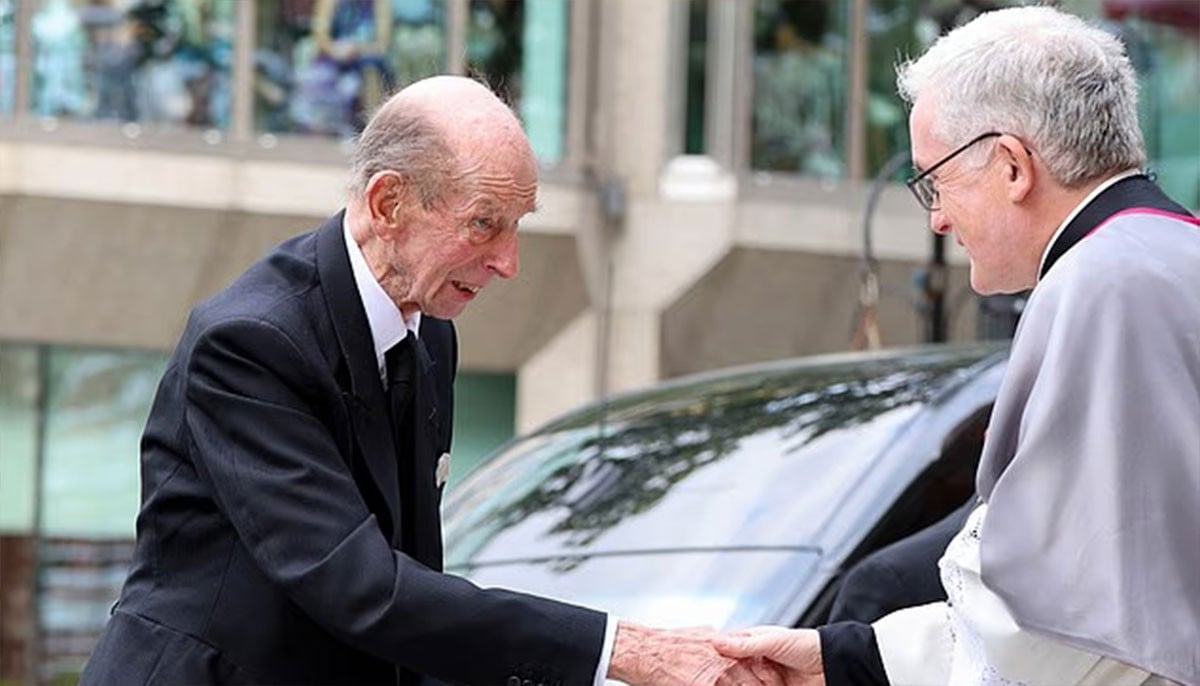
The Duke of Kent has made a…
WHAT
The African Union Healthy Lifestyle Day 2025 will be held under the theme: Mental Health in the Family with the slogan: Healthy Home, Healthy Workplace.
The event aims to promote family-centered mental health and overall well-being among AU…
Welcome to WordPress. This is your first post. Edit or delete it, then start writing!

“Parents of a child age 12 or younger” and “parents” refer to U.S. adults who are parents or guardians of at least one child age 12 or younger.
Parents with more than one child age 12 or younger were asked to answer about one randomly selected child and may have children in other age groups. Child age groups throughout the report refer to the randomly selected child.
Throughout this report, “older child” generally refers to a child age 5 or older.
Parenting today means making tough choices about technology. Screens can educate and entertain, but managing what kids watch – and how much – can leave parents feeling judged or like they should be doing more. Setting limits can be a challenge even for those with the youngest kids.

A Pew Research Center survey of U.S. parents reveals how widespread technology is for kids ages 12 and younger – and the day-to-day reality of managing screen time as a parent. Among the takeaways:
Tablets and smartphones are common – TV even more so.
Nine-in-ten parents of kids ages 12 and younger say their child ever watches TV, 68% say they use a tablet and 61% say they use a smartphone.
Half say their child uses gaming devices. About four-in-ten say they use desktops or laptops.
AI is part of the mix.
About one-in-ten parents say their 5- to 12-year-old ever uses artificial intelligence chatbots like ChatGPT or Gemini.
Roughly four-in-ten parents with a kid 12 or younger say their child uses a voice assistant like Siri or Alexa. And 11% say their child uses a smartwatch.
Screens start young.
Some of the biggest debates around screen time center on the question: How young is too young?
It’s not just older kids on screens: Vast majorities of parents say their kids ever watch TV – including 82% who say so about a child under 2.

Smartphone use also starts young for some, but how common this is varies by age. About three-quarters of parents say their 11- or 12-year-old ever uses one. A slightly smaller share, roughly two-thirds, say their child age 8 to 10 does so. Majorities say so for kids ages 5 to 7 and ages 2 to 4.
And fewer – but still about four-in-ten – say their child under 2 ever uses or interacts with one.
It’s common for children to use smartphones. But at what age do they typically start owning their own devices?

In our survey, about one-in-four parents say their child has a smartphone of their own.
This depends heavily on the child’s age. Roughly six-in-ten parents of an 11- or 12-year-old say their child has their own smartphone, compared with 29% of parents of an 8- to 10-year-old and about one-in-ten who say so about a younger kid.
Kids’ smartphone ownership also varies by household income, with 31% of parents with lower incomes reporting that their child has their own smartphone. Smaller shares of those with middle (20%) and upper incomes (16%) say the same.
Regardless of whether a child has their own phone, we asked parents what they consider to be an appropriate age for kids in general to have one. Most parents (68%) think kids generally should be at least 12 before getting a smartphone of their own.
Even for the youngest kids, YouTube is widely used.
YouTube has played a major role in kids’ tech use over the years. It’s not without criticism; lawmakers and advocates have called out the advertising shown to kids and the quality of the content they see. Still, even as parents have voiced similar concerns in our past surveys, they have also noted its role in kids’ entertainment and learning.

Today, 85% of parents say their child ever watches YouTube; this includes about half who say this happens daily. And the platform is widely used by kids of all ages.
About six-in-ten parents report that their child under 2 watches YouTube. This rises to 84% for ages 2 to 4 and is slightly higher for ages 5 to 12.
YouTube use is ticking up overall – and has risen sharply for kids under 2.

YouTube use overall has inched up from 2020, when 80% of parents said their child 11 or younger ever watched it, to 85% of parents who say their child 12 or younger ever does so today.
That includes a jump from 45% to 62% among parents of a child under 2. The shares of parents who say their kid 2 and up ever watches YouTube are statistically unchanged.
Daily use also rose from 43% in the 2020 survey to 51% today. This change is driven by more parents saying their younger kid watches YouTube daily. From 2020 to 2025, daily use rose from:
Some parents say their kids are on TikTok and other social media platforms.
Social media companies have been accused of being too lax with kids’ data, harming youth mental health and not doing enough to keep children from seeing inappropriate content.

Though companies have put age restrictions in place, some kids are still on these platforms. As in 2020, TikTok stands out from the other platforms we asked about – with 15% of parents saying their child uses it, as far as they know.
Smaller shares report their child uses Snapchat (8%), Instagram or Facebook (5% each).
It’s most common for parents of the oldest kids to say their child uses these four platforms. For example, 37% of parents say their 11- to 12-year-old uses TikTok. By comparison:
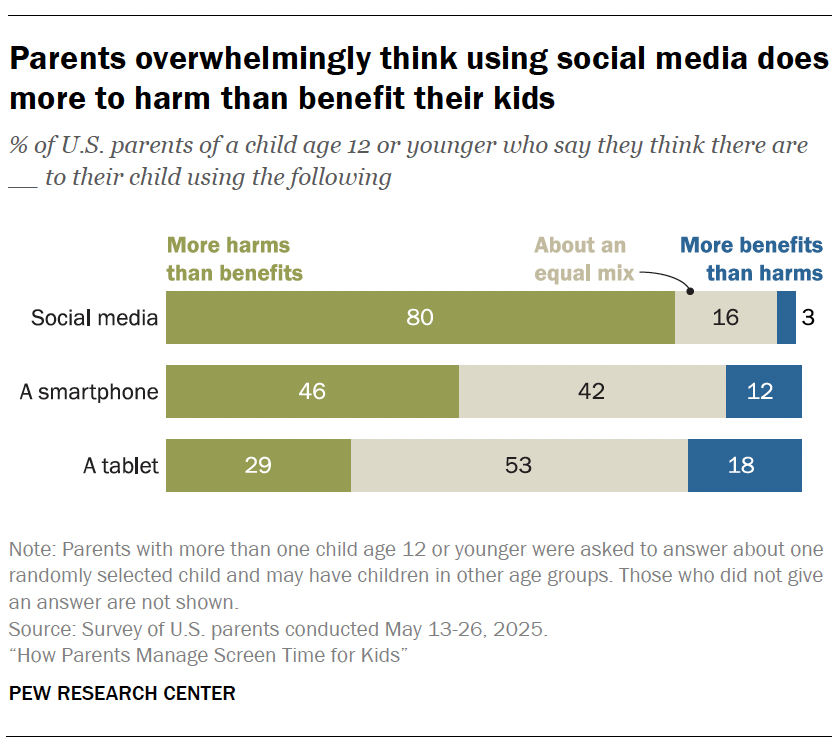
At the same time, parents view social media as uniquely harmful. Eight-in-ten say the harms of social media outweigh the benefits.
Fewer, though still nearly half, say smartphones are more harmful than beneficial to their children.
And a smaller share – about three-in-ten – say the same about tablets.
Parents can face tough calls daily on screen time. When and why kids are allowed to use a smartphone can be among the most fraught.
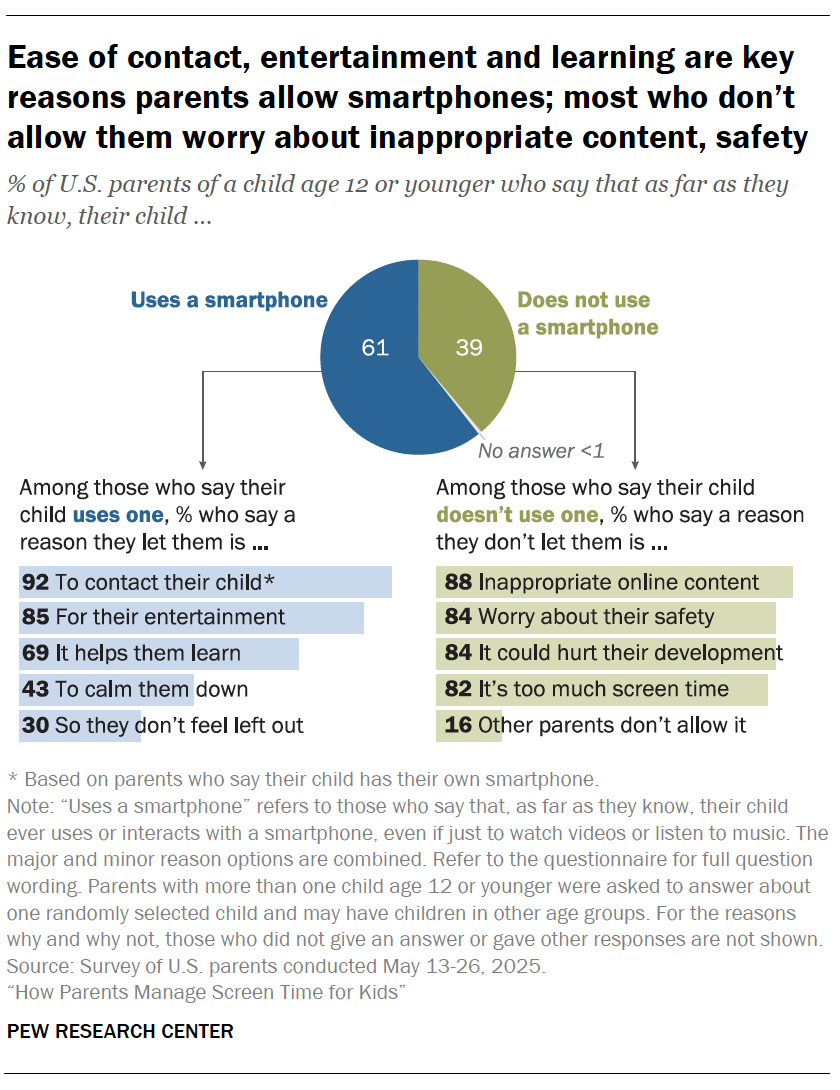
Ease of contact is a big reason for allowing kids to have their own smartphones. Nearly all parents whose child has their own smartphone say this is a major or minor reason they let them use one.
Most parents who let their kids use smartphones at all say entertainment and learning are reasons they do so. Smaller but notable shares of parents say they let kids use smartphones to calm them down or so that they don’t feel left out.
Among parents whose kids use smartphones, those whose child is under 5 are far more likely than those with older kids to say calming their child is a reason they allow smartphone use. And those with lower household incomes are more likely than those with middle or upper incomes to let their child use a smartphone to help them learn, to avoid them feeling left out or to calm them.
Most parents who don’t allow smartphones say inappropriate content is a reason why. Safety, developmental concerns and excessive screen time are also commonly cited.
In addition to surveying parents, we also conducted four separate focus groups in March to dive deeper into parents’ views and experiences on topics related to screen time. In the discussions, we asked them how they felt about their kids using – or not using – phones in general.
One parent highlighted safety as a reason their child has one, explaining:
“[My son’s] in kinder[garten], and he owns his phone already. It is for safety reasons only … so he takes it every day to school, brings it back, but he never uses it.”
Asked about giving kids phones in the future, another parent said:
“I think eventually we will give it to them, but now … she’s not ready. Even … we [parents] spend too much time on phones. … How can we expect a 9-year-old to control and have a balance between their screen time?”
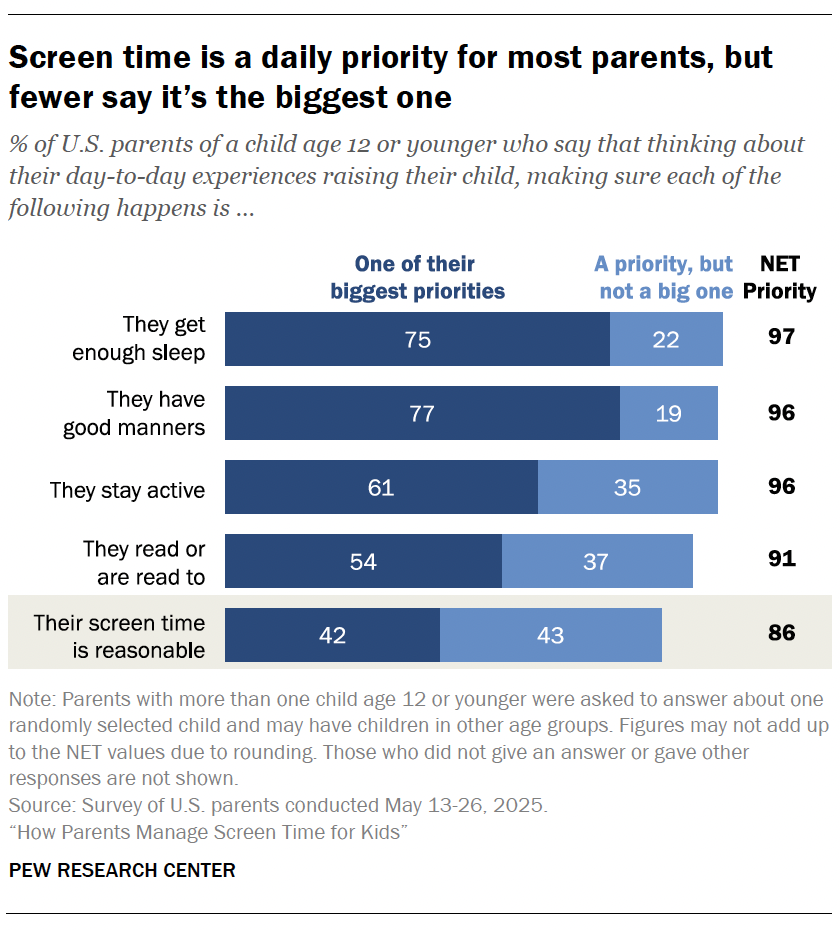
Most parents say managing their child’s screen time is a priority. Fewer than half say it’s one of their biggest ones.
Our survey findings show that they’re juggling other things: Larger shares say making sure their child has good manners, gets enough sleep, stays active, and reads or is read to are some of their biggest day-to-day priorities.
About nine-in-ten parents with upper (90%) and middle incomes (87%) say screen time is a priority overall, higher than the 82% with lower incomes who say so. But the shares who say it’s one of their biggest priorities are similar across these groups.
Some of the other key priorities parents cite vary by income, though. For example, 84% of parents with lower incomes say ensuring good manners is one of their key priorities, versus 74% of those with middle incomes and a slightly smaller share of those with upper incomes (69%).
About four-in-ten parents (39%) think they’re stricter about their child’s screen time than other parents they know.
By comparison, about a quarter each think they’re less strict than other parents (26%) or about as strict (28%).
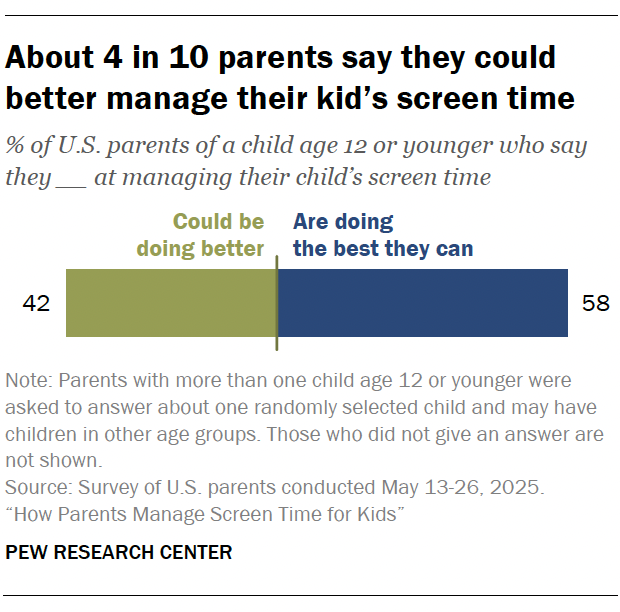
Many parents say they’re doing their best; some think they can do more.
About four-in-ten (42%) say they could be doing better at managing their kid’s screen time. A larger share – 58% – say they’re doing the best they can.
Moms and dads are similarly likely to say they’re doing their best (59% vs. 55%). Parents with lower household incomes, though, are more likely than their middle-income peers to say this (63% vs. 54%). (Those with upper incomes do not differ from either group, at 57%.)
In our March focus groups, we heard from parents about competing pressures that can weigh heavily on them. As one parent said:
“I also have three other children in the house, and I work full time. … To just keep some of my sanity, the first thing I do is turn the TV on. … Being the wintertime, it’s hard for them to go outside. … I want to work on the screen time for the summertime.”
And parents want tech companies and lawmakers to take more action to protect kids.
Two-thirds of parents (67%) say tech companies should do more to set rules around what kids can do or see online, according to our May survey. And a 55% majority say that lawmakers should do more.
Parental support for action on kids’ online lives crosses partisan lines. There are only slight differences in views for Republican and Democratic parents, including parents who lean toward each party.

Singapore provided another contentious intra-team McLaren moment, as Lando Norris overtook Oscar Piastri in the opening corners of the race, with the help of a bit of contact. It was a race where you could sense the Australian’s growing…

What do you do when you want to observe something that’s on the other side of the Sun?
That’s the problem astronomers faced as October 2025 rolled around and comet 3I/ATLAS, the mysterious interstellar visitor, became lost in solar glare, as seen…